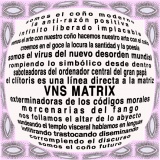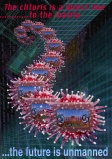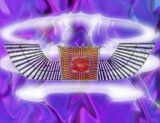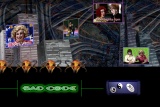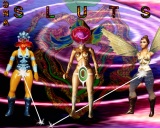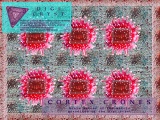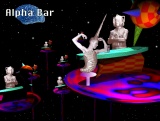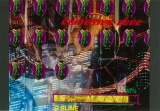Difference between revisions of "VNS Matrix"
| Line 9: | Line 9: | ||
VNS Matrix 1.jpg | VNS Matrix 1.jpg | ||
VNS Matrix 2.jpg | VNS Matrix 2.jpg | ||
| − | + | VNS_Matrix_1991_A_Cyberfeminist_Manifesto_for_the_21st_Century.jpg | |
VNS Matrix 4.jpg | VNS Matrix 4.jpg | ||
VNS Matrix 5.jpg | VNS Matrix 5.jpg | ||
Revision as of 13:54, 15 June 2019
VNS Matrix (articulated as V.N.S. a fauxcronym) was a cyberfeminist media art collective formed in Adelaide (South Australia) in 1991. From 1991-97 they presented installations and public art works in Australia and overseas, working with new media, photography, sound and video. Their works include installations, events, imagery and propaganda distributed through the Internet, zines, and billboards. Taking their point of departure in a sexualised and socially provocative relationship between women and technology the works subversively questioned discourses of domination and control in the expanding cyber space.
The first of their works (a large scale billboard), inspired by such theorists as Donna Haraway and Sadie Plant, featured their seminal text "A Cyberfeminist Manifesto for the 21st Century". It was in this manifesto that the term cyberfeminism first appeared, and this work was widely distributed. In the manifesto, VNS Matrix stated that, "we are the modern cunt/positive anti reason/unbounded unleashed unforgiving" and that, "we are the virus of the new world disorder/rupturing the symbolic from within/saboteurs of big daddy mainframe/the clitoris is a direct line to the matrix/the VNS Matrix". The group disbanded in 1997, but occasionally work together on selected projects and presentations. Their parting manifesto Bitch Mutant Manifesto gave the finger to all technopatriarchies and capitalist infospheres with the words "suck my code" amongst other blasphemous exhortations.
VNS Matrix was and is Josephine Starrs, Julianne Pierce, Francesca da Rimini, and Virginia Barratt. (Source)
Gallery
Writings and interviews
- VNS Matrix, A Cyberfeminist Manifesto for the 21st Century, Adelaide & Sydney, 1991, HTML; printed in Broadsheet 21(1): "Adelaide Festival Special Issue", Mar 1992; repr. in Art and Text 42, May 1992; repr. in Women, Computing and Culture, eds. P. Bishop, M. Dyer and P. Griffin, Adelaide: University of South Australia, 1994, p 110; repr. in Unnatural: Techno-Theory for a Contaminated Culture, ed. Matthew Fuller, London: Underground, 1994. [1] [2] [3]
- "Manifeste cyber féministe pour le 21ème siècle", in Connexions: art, réseaux, média, eds. Annick Bureaud and Nathalie Magnan, Paris: École nationale Supérieure des Beaux-Arts, 2002, pp 545-546. [4] (French)
- in Kabinet 8, eds. V. Mazin and O. Turkov, St Petersburg, 1994, pp 117-121. (Russian)
- VNS Matrix, "All New Gen", Framework 6(2): "Art & Technology", ed. Peter Lunenfeld, May 1993; repr. in Unnatural: Techno-Theory for a Contaminated Culture, ed. Matthew Fuller, London: Underground, 1994; repr. in Virtual Futures: Cyberotics, Technology and Post-Humanism, eds. J. Broadhurst Dixon and E.J. Cassidy, London: Routledge, 1998, pp 37-42.
- in Kabinet 8, eds. V. Mazin and O. Turkov, St Petersburg, 1994, pp 117-121. (Russian)
- VNS Matrix, "Pathogenic Vectors", in ISEA '94: The 5th International Symposium on Electronic Art Catalogue, ed. Minna Tarkka, Helsinki: University of Art & Design Helsinki, Aug 1994, p 158.
- "VNS Matrix and Virginia Barratt interviewed by Bernadette Flynn", Continuum: Journal of Media and Cultural Studies 8(1): "Electronic Arts in Australia", 1994, pp 419-432.
- VNS Matrix, "Bitch Mutant Manifesto", Apr 1996; printed in Feminist Art Manifestos: An Anthology, ed. Katy Deepwell, London: KT press, 2014.
- VNS Matrix, "Nothing is Certain: Flesh, the Postbody and Cyberfeminism. VNS Matrix in Conversation with Nora Delahunty", in Memesis: The Future of Evolution, ARS Electronica ’96, Vienna, 1996, PDF.
- Mary-Anne Breeze, "Attack of the CyberFeminists: The Art, Times and Genderings of VNS Matrix + e-nter-view/of/with Gashgirl", Switch 4:1, 1998.
- Claire L. Evans, "An Oral History of the First Cyberfeminists", Motherboard, 11 Dec 2014.
- Evelyn Wang, "The Cyberfeminists Who Called Themselves ‘The Future Cunt’", Dazed, 15 Nov 2016.
- more
Literature
- Jyanni Steffensen, "Girls in (Cyber)Space", Broadsheet 22:4, Dec 1993, p 16. Review of the exhibition All New Gen by VNS Matrix.
- Zoe Sofia, "Against 'Neofuturism': Women Artists in Technological Media", Artlink 13:1, Mar 1993. [5] [6]
- Kay Schaffer, "The Game Girls of VNS Matrix: Challenging Gendered Identities in Cyberspace", in Sexualities in History: A Reader, eds. Kim M. Phillips and Barry Reay, New York: Rouledge, 2002, pp 434-452.
- Claire L. Evans, "'We Are the Future Cunt': CyberFeminism in the 90s", Motherboard, 20 Nov 2014.

